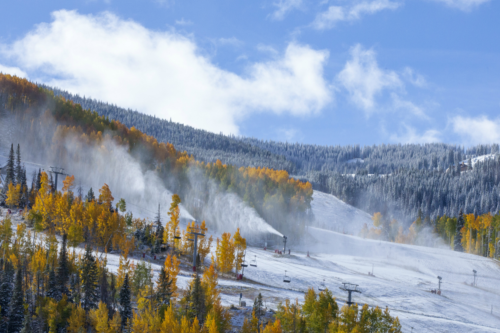This website uses cookies to ensure you get the best experience on our website. To read our full cookie policy please click here.
Vail Resorts: Eco skiing in action
A ski resort sending zero waste to landfill?
A ski resort operating with zero net impact on forests and habitat and zero net emissions?
No you’re not dreaming, this is the bold and “Epic Promise” made by Vail Resorts a few years ago, one they are well on their way to achieving.
Abigail Butcher gets the lowdown.
Thanks to Vail Resorts for use of images.
In 2017, Vail Resorts promised to achieve a “zero net operating footprint” by 2030 and as the world’s biggest owner and operator of ski resorts (34 in North America and three in Australia), the Colorado-based company is leading the way in sustainability practices and smashing through its “Commitment to Zero” goals.
Among the impressive steps already taken is contracts with massive wind farms in Nebraska and Utah that will provide more than 93 per cent of the electricity required by Vail Resorts’ operations in North America by 2023, donations and grants of more than $20 million to non-profit partners and community organisations, a reduction in greenhouse gas emissions by 20.7 per cent and progress towards its goal of 15 per cent energy efficiency savings. By partnering with Eco-Products and PepsiCo to use more compostable packaging, tumblers and cups, implementing new composting facilities and donating excess food to local food banks, schools and community organisations, Vail Resorts has already halved the amount it sends to landfill.
When in June 2021, Vail Resorts announced it was putting its mission to combat climate change ahead of competition by signing the Climate Collaboration Charter with rivals Alterra Mountain Company, Boyne Resorts and POWDR, EcoSki decided it was time for a chat.
We tracked down Kate Wilson, Vail Resorts’ senior director of sustainability, to find out more about the Epic Promise and what other ski resorts can learn from their lead.


ES: Zero to landfill is huge for one ski resort, let alone 37. How are you doing on that?
KW: This is arguably the most challenging pillar of Commitment to Zero. When we launched it [in 2017], we set a sub-goal to reach 50 per cent waste diversion from landfill by the end of 2020 for the 16 resorts in our portfolio at that time. We’re proud that we officially reached that milestone in March 2020, nearly a year ahead of schedule, by reducing landfill waste and increasing composting and recycling. Key projects include implementing new waste sorting systems and collaboration with local partners to support improved composting and recycling infrastructure.
ES: What is going to be the toughest thing to change?
KW: One of the hardest challenges remaining is tackling ski equipment — skis, snowboard, boots, poles — and how to upcycle them. We are working to address this, but as with many aspects of waste, this takes innovation and creativity because large-scale operations do not exist yet in all of our markets.
ES: One of the hardest parts of mitigating climate change is getting the public on board — how are you educating your staff and guests?
KW: We hope Commitment to Zero inspires guests and employees alike as we cannot achieve a zero net operating footprint by 2030 without the support of both — particularly on zero to landfill. Our commitment includes training for employees across our organisation and messaging to guests that makes sorting and waste management easier.
ES: Has the Covid pandemic interrupted progress?
KW: During the last season (winter 2020/2021) our waste streams temporarily changed significantly — we had more single-use items that we had previously replaced with durable items in our restaurants. In order to ensure we kept up our ‘muscle memory’ of Commitment to Zero during the pandemic we created a campaign called ‘Know Before You Throw’ for employees, where we added specific sorting guidance through our employee app and provided sorting training on how to make sure we were most responsibly addressing these temporary items.
ES: One of the biggest issues associated with ski holidays is transport and there are very few public transport options to North American ski resorts. What steps are you taking to conquer this?
KW: Currently, Vail Resorts does not measure Scope 3 (indirect) emissions as part of our annual inventory. At this point, we’re focussed on achieving zero net emissions through our operations — with 37 resorts in 15 states and three countries, Commitment to Zero will allow us to have a big impact on preserving the environment through our operations.
That said, we do take on a number of activities and projects that reduce Scope 3 emissions, such as providing electric vehicle charging to guests, carpooling apps for employees, ensuring we recycle e-waste, reducing business travel and reducing waste-related emissions by composting and recycling.
ES: When you are market leading already, why was it important to collaborate with your competitors?
KW: As companies rooted in the great outdoors, we each recognise the significant threat of climate change and have a unique responsibility to protect and preserve the majestic environment in which we operate. We know that together we can do more to mitigate the impacts of climate change than we could individually.
Favourite stories



